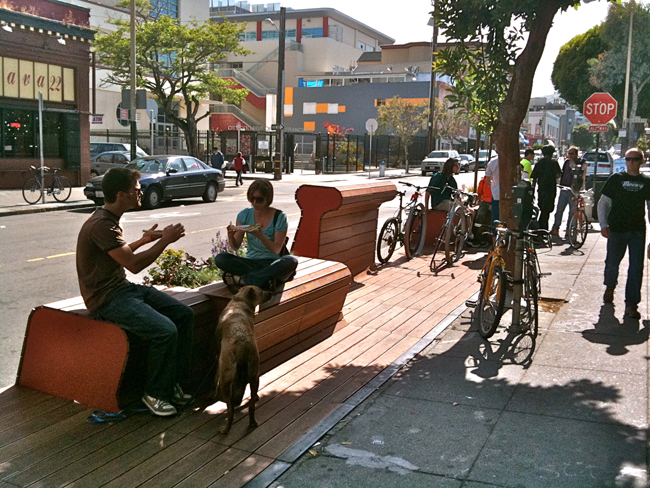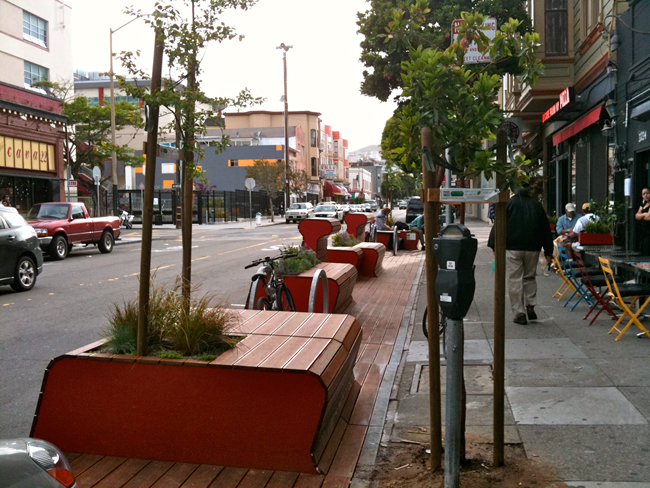Life in the Slow Lane














Mini-parks built atop parking spaces are cropping up throughout San Francisco. The trend is spreading to other cities, as well.
| Photo ' Søren Schaumberg Jensen/REBAR |
|
Rebar, a San Francisco firm, designed a parklet outside of Tony’s Pizza Napoletana in the North Beach neighborhood. |
It’s the ultimate revenge on the modern city: one less parking space, one more park. A century and a half after San Francisco city planner Jasper O’Farrell was driven out of town by a lynch mob for taking farmers’ land to widen Market Street, parklets are reversing his folly, expanding the sidewalk into the flow of traffic, reclaiming street for feet.
Nearly two dozen of these miniparks, designed by a coterie of local architects, have appeared in neighborhoods across the city, from Outer Sunset to the Financial District. Built atop parking spaces in front of cafés, galleries, and shops, these slivers of refuge often contain planters, bike racks, and tables at which passersby can enjoy their locally roasted macchiatos. Technically temporary, they’re designed to slip through city bureaucracy. Permits last one year, at which point the parklet is reevaluated at a public hearing. “It’s representative of a new kind of city planning: full-scale prototypes and iterative, changeable design,” says Matthew Passmore of the firm Rebar, which has designed and built three parklets so far.
Seemingly overnight, parklets sprout: driftwood benches outside Trouble Coffee, undulating bamboo planks fronting Revolution Café, a scrap-wood playground before the Fabric8 art gallery. Now emerging in places like Vancouver, Philadelphia, and Chicago, parklets are a San Francisco phenomenon, thronged with sunbathers on fog-free days but defamed by drivers in a city where fickle public transit and complex parking rules make the rare spot as good as gold.
The city’s parklet movement took root several years ago. In late 2008, inspired by Gansevoort Plaza—a pop-up seating area in a bustling intersection in Manhattan’s Meatpacking District—San Francisco launched an experiment on a congested corner in the Castro: It built a pocket park. Concrete barriers, a few tables, and a row of potted trees went up; locals gathered for lunch and people watching; bureaucrats blanched. “The notion of its being exploratory, doing something temporary, was so foreign to career bureaucrats,” said Andres Power, project manager of the city’s Pavement to Parks program, established in 2009. “They said it’s too dangerous—you have streetcars, multiple grids coming together. Our response was, it’s the best place to figure out if it can work, and make changes if it doesn’t.”
The experiment was a success. Power and his team quickly built two more plazas like it in neighboring Noe Valley; then in early 2010, they turned their program loose with a public call for proposals for parklets throughout the city. Forty came in; 20 permits went out. Their next RFP, in June of this year, netted 40 more. Permits are now being issued.
The parklets are permitted by a trio of city agencies—Planning, Public Works, and the MTA—but must be funded, built, and maintained by whoever applies for them (typically owners of cafés, galleries, and stores). City oversight boils down to one simple rule that is enforced by plainclothes inspectors: The space must be public.
The parklets have drawn criticism, from similar circles that fought and killed a proposal for food stands in the city’s beloved Dolores Park and continue to battle the notion of POPOS (privately owned public open spaces) in downtown. Opponents argue that a parklet’s extra seating is a revenue generator veiled as public good. Then there’s the occasional voicing of the car driver’s plight. One more parklet, after all, means two or three fewer places to park.
I’ve seen firsthand how incendiary parklets can be. Enjoying a fair-trade espresso one morning in a parklet outside of Four Barrel Coffee, I was heckled by a passing driver: “How’s it feel to take away my parking spot?” he shouted, peppering his speech with curses.
While the city loses an estimated $5,000 per year in parking fees for each spot (and meter) removed, it gains an array of public gathering places. Built independently, quickly, and cheaply—usually between $7,000 and $20,000, often with materials and funds donated by neighbors—each parklet is defiantly unique, from Four Barrel’s bike rack–cum–garden trellis to Terroir wine shop’s planned bocce ball court. “If this was a typical, permanent city project, you wouldn’t see that level of creativity,” Power says.
Perhaps most notably, parklets give urban dwellers a place to kick back amid the bustle of the city. Says Seth Boor, whose studio, Boor Bridges, designed the Four Barrel parklet, “It’s like having the front porch and yard that none of us has.”








